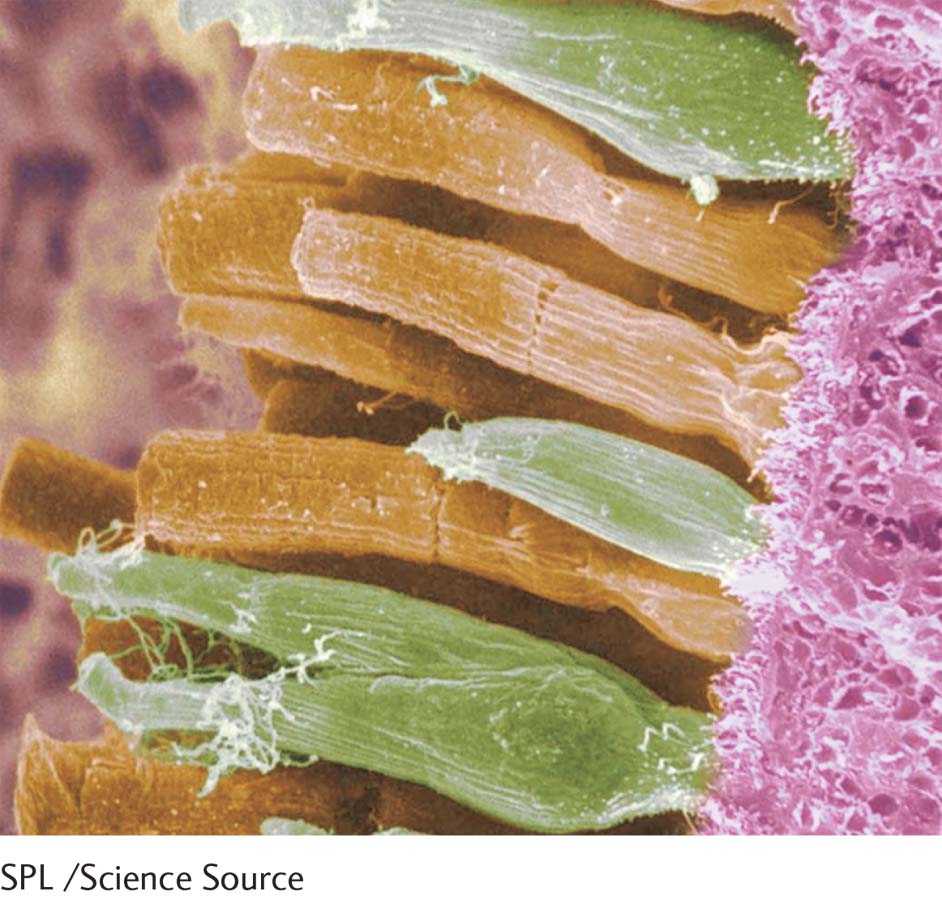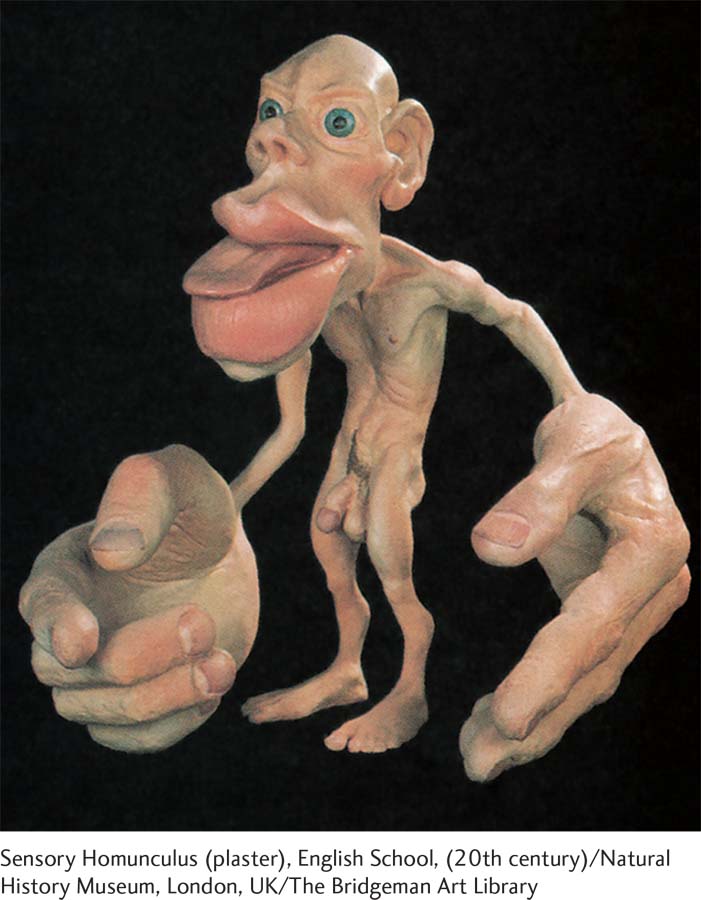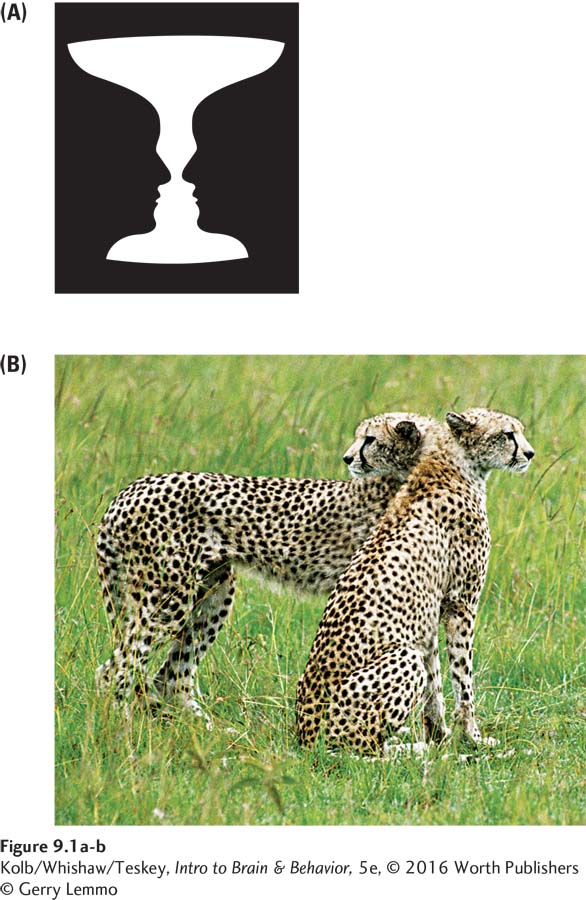9-1 Nature of Sensation and Perception
We may believe that we see, hear, touch, smell, and taste real things in a real world. In fact, the only input our brain receives from the “real” world is a series of action potentials passed along the neurons that form our various sensory pathways. Although we experience visual and body sensations as fundamentally different from one another, the nerve impulses coursing in the neurons of these two sensory systems are quite similar, as are the neurons themselves.
Neuroscientists understand how nerves can turn energy, such as light waves, into nerve impulses. They also know the pathways those nerve impulses take to reach the brain. But they do not know how we end up perceiving one set of nerve impulses as what the world looks like and another set as what makes us move.
How much of what you know comes through your senses? Taken at face value, this question seems reasonable. At the same time, we realize that our senses can deceive us—
Our sensory systems appear to be extremely diverse: vision, audition, touch, taste, and olfaction appear to have little in common at first glance. Although our perceptions and behaviors in relation to them differ, each sensory system is organized on a similar hierarchical plan. We now consider the features common to the sensory systems—
Sensory Receptors
Sensory receptor neurons are specialized to transduce (convert) sensory energy—

For vision, the photoreceptors in the retina convert light energy into chemical energy, which is in turn converted into action potentials.
In the auditory system, air pressure waves are first converted into mechanical energy, which activates the auditory receptors that produce action potentials in auditory receptor neurons.
In the somatosensory system, mechanical energy activates receptors sensitive to touch, pressure, or pain. These somatosensory receptors in turn generate action potentials in somatosensory receptor neurons.
Page 286For taste and olfaction, various chemical molecules in the air or in food fit themselves into receptors of various shapes to activate action potentials in the respective receptor neurons.
Were our visual receptors somewhat different, we would be able to see in the ultraviolet as well as the visible parts of the electromagnetic spectrum, as honeybees and butterflies can. Receptors in the human ear respond to a wide range of sound waves, but elephants and bats can hear and produce sounds far below and above, respectively, the range humans can hear. In fact, in comparison with those of other animals, human sensory abilities are about average.
An animal’s perception of the world depends on its nervous system’s complexity and organization.
Even our pet dogs have “superhuman” powers: they can detect trace odors; hear low-
Receptive Fields
Every sensory receptor organ and cell has a receptive field, a specific part of the world to which it responds. If you fix your eyes on a point directly in front of you, for example, what you see of the world is the scope of your eyes’ receptive field. If you close one eye, the visual world shrinks. What the remaining eye sees is the receptive field for that eye.
Each photoreceptor cell in the eye points in a slightly different direction and so has a unique receptive field. You can grasp the conceptual utility of the receptive field by considering that the brain uses information from each sensory receptor’s receptive field not only to identify sensory information but also to contrast the information each receptor field is providing.
Receptive fields not only sample sensory information but also help locate events in space. Because adjacent receptive fields may overlap, the contrast between their responses to events help us localize sensations. This spatial dimension of sensory information produces cortical patterns and maps that form each person’s sensory reality.

Our sensory system is organized to tell us both what is happening in the world around us and what in the world we are doing ourselves. When you move, you change the perceived properties of objects, and you sense things that have little to do with the external world. When we run, visual stimuli appear to stream by us, a stimulus configuration called optic flow. When you move past a sound source, you hear an auditory flow, a gradual shift in sound intensity that takes place because of your changing location. Optic flow and auditory flow are useful for telling us how fast we are going, whether we are going in a straight line or up or down, and whether we or an object in the world is moving.
Try this experiment. Slowly move your hand back and forth before your eyes and gradually increase its speed. Eventually, your hand will get a little blurry, because your eye movements are not quick enough to follow its movement. Now keep your hand still and move your head back and forth. The image of your hand remains clear. When receptors in the inner ear inform your visual system that your head is moving, the visual system compensates for the head movements, and you observe the hand as a stationary image.
Receptor Density and Sensitivity
Receptor density is particularly important for determining a sensory system’s sensitivity. For example, tactile receptors on the fingers are numerous compared with those on the arm. The difference explains why fingers can discriminate touch remarkably well and the arm cannot.
Our sensory systems use different receptors to enhance sensitivity under different conditions. For example, the visual system uses different sets of receptors to respond to light and color. Color photoreceptors are small and densely packed to make sensitive color discriminations in bright light. Receptors for black–
Differences in density of sensory receptors determine many animals’ special abilities—
Neural Relays
Inasmuch as receptors are common to each sensory system, all receptors connect to the cortex through a sequence of three or four intervening neurons. The visual and somatosensory systems have three relays, and the auditory system has four. Information can be modified at various stages in the relay, allowing the sensory system to mediate different responses. Once again, this is very different from the sensory images on a TV screen or from an audio system: information is being modified repeatedly as the brain constructs the image or sound.
Neural relays also allow sensory systems to interact. There is no straight-
Recall the principle from Section 2-6: brain systems are organized hierarchically and in parallel.
Some of the three or four relays in each sensory system are in the spinal cord; others, in the brainstem; and still others, in the neocortex. At each level, the relay allows a sensory system to produce relevant actions that define the hierarchy of our motor behavior. For example, the first relay for pain receptors in the spinal cord is related to reflexes that produce withdrawal of a body part from a painful stimulus. Thus, even after section of the spinal cord from the brain, a limb still withdraws from a painful stimulus.
A dramatic effect of sensory interaction is the visual modification of sound. If a person hears a speech syllable such as ba while observing someone who is articulating ga, the listener hears not the actual sound ba but a hybrid sound, da. The viewed lip movements modify the listener’s auditory perception.
This interaction effect is potent: it highlights the fact that a speaker’s facial gestures influence our perception of speech sounds. As Roy Hamilton and his coworkers (2006) described, synchrony of gestures and sounds is an important aspect of language acquisition. The difficulty of learning a foreign language can relate to the difficulty of blending a speaker’s articulation movements with the sounds the speaker produces.
Sensory Coding and Representation
After it has been transduced, all information from all sensory systems is encoded by action potentials that travel along peripheral nerves in the somatic nervous system until they enter the spinal cord or brain. From there the action potentials travel on nerve tracts within the central nervous system. Every bundle carries the same kind of signal. How do action potentials encode different sensations? (How does vision differ from touch?) How do they encode the features of particular sensations? (How does purple differ from blue?)
Recall the principle from Section 2-6: the nervous system works by juxtaposing excitation and inhibition.
Parts of these questions seem easy to answer; others pose a fundamental challenge to neuroscience. The presence of a stimulus can be encoded by an increase or decrease in a neuron’s discharge rate, and the amount of increase or decrease can encode stimulus intensity. As detailed in Section 9-4, qualitative visual changes, such as from red to green, can be encoded by activity in different neurons or even by different levels of discharge in the same neuron. (For example, more activity might signify redder and less activity, greener.)

What is less clear is how we perceive such sensations as touch, sound, and smell as different from one another. Part of the explanation is that each sensation is processed in its own distinct cortical region. Also, we learn through experience to distinguish them. Third, each sensory system has a preferential link with certain reflexive movements, constituting a separate wiring that helps keep each system distinct at all levels of neural organization. For example, pain stimuli produce withdrawal responses, and fine-
The distinctions among the sensory systems, however, are not always clear: some people hear in color or identify smells by how the smells sound to them. This mixing of the senses is called synesthesia. Anyone who has shivered when hearing a piece of music or at the noise chalk or fingernails can make on a blackboard has felt sound.
In most mammals, the neocortex represents the sensory field of each modality—
Perception
Sensation is far more than the simple registration of physical stimuli from the environment by the sensory organs. Compared with the richness of actual sensation, our description of sensory neuroanatomy and function is bound to seem sterile. Part of the reason for the disparity is that our sensory impressions are affected by the context in which they take place, by our emotional state, and by our past. All these factors contribute to perception, the subjective experience of sensation—
Clear proof that perception is more than sensation lies in the fact that different people transform the same sensory stimulation into totally different perceptions. The classic demonstration is an ambiguous image such as the well-
Similarly, the photograph of two cheetahs in Figure 9-1B is ambiguous. Which head goes with which cheetah? As with the Rubin’s vase, the two perceptions may alternate. Such ambiguous images and illusions demonstrate the workings of complex perceptual phenomena and enlighten our insight into our cognitive processes.

9-1 REVIEW
Nature of Sensation and Perception
Before you continue, check your understanding.
Question 1
____________ are energy filters that transduce incoming physical energy into neural activity.
Question 2
fields locate sensory events. Receptor ____________ determines sensitivity to sensory stimulation.
Question 3
We distinguish one sensory modality from another by its ____________.
Question 4
Sensation registers physical stimuli from the environment by the sensory organs. Perception is the ____________.
Question 5
How is the anatomical organization similar for each sense?
Answers appear in the Self Test section of the book.
